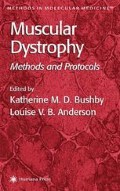Abstract
The preceding chapters have dealt with the detection of gene mutations and the following chapters deal with protein analysis. This chapter links the two by describing the effect that different types of mutations have on protein synthesis, and how this may be used in the investigation of muscular dystrophy (MD). Analysis at the DNA level can be performed with a simple blood sample, but analysis at the protein level requires a sample of the tissue expressing the target protein. Although proteins such as emerin may be detected in a skin biopsy, most of the diagnostic proteins are only expressed in muscle. The taking of a skeletal muscle biopsy for histological analysis has been part of the routine for a diagnostic work-up for many years, and the practice of storing such samples in an archive was of great importance when diagnostic protein analysis first started in the MDs, with the identification of the Duchenne/Becker gene product, dystrophin. Now that there is an increasing range of gene products to analyze, the taking of a muscle biopsy is an invaluable asset to the diagnostic protocol (1), and analysis of protein expression is established as an essential link between the underlying genotype and the manifestations of clinical severity.
Access this chapter
Tax calculation will be finalised at checkout
Purchases are for personal use only
References
Anderson, J. R. (1997) Recommendations for the biopsy procedure and assessment of skeletal muscle biopsies. Virchows Arch. Int. J. Pathol. 431, 227–233.
Anderson, L. V. B. (1996) Optimised protein diagnosis in the autosomal recessive limb-girdle muscular dystrophies. Neuromusc. Disord. 6, 443–446.
Nigro, V., de Sá Moreira, E., Piluso, G., Vainzof, M., Belsito, A., Politano, L., et al. (1996) Autosomal recessive limb-girdle muscular dystrophy, LGMD2F, is caused by a mutation in the δ-sarcoglycan gene. Nature Genet. 14, 195–198.
Bönnemann, C. G., Passos-Bueno, M. R., McNally, E. M., Vainzof, M., de Sá Moreira, E., Marie, S. K., et al. (1996) Genomic screening for β-sarcoglycan gene mutations: Missense mutations may cause severe limb-girdle muscular dystrophy type 2E (LGMD 2E). Hum. Mol. Genet. 5, 1953–1961.
Sewry, C., Taylor, J., Anderson, L. V. B., Ozawa, E., Pogue, R., Piccolo, F., et al. (1996) Abnormalities in α-, β-and γ-sarcoglycan in patients with limb-girdle muscular dystrophy. Neuromusc. Disord. 6, 467–474.
Vainzof, M., Passos-Bueno, M. R., Canovas, M., de Sá Moreira, E., Pavanello, R. C. M., Marie, S. K., et al. (1996) The sarcoglycan complex in the six autosomal recessive limb-girdle muscular dystrophies. Hum. Mol. Genet. 5, 1963–1969.
England, S., Nicholson, L. V. B., Johnson, M. A., Forrest, S. M., Love, D. R., Zubrzycka-Gaarn, E. E., et al. (1990) Very mild muscular dystrophy associated with the deletion of 46% of dystrophin. Nature 343, 180–182.
Vincent, N., Ragot, T., Gilgenkrantz, H., Couton, D., Chafey, P., Grégoire, A., et al. (1993) Long-term correction of mouse dystrophic degeneration by adenovirusmediated transfer of a minidystrophin gene. Nature Genet. 5, 130–134.
Nicholson, L. V. B., Johnson, M. A., Bushby, K. M. D., Gardner-Medwin, D., Curtis, A., Ginjaar, H. B., et al. (1993) Integrated study of 100 patients with Xp21 muscular dystrophy using clinical, genetic, immunochemical, and histopathological data. Part 2: Correlations within individual patients. J. Med. Genet. 30, 737–744.
Malhotra, S. B., Hart, K. A., Klamut, H. J., Thomas, N. S. T., Bodrug, S. E., Burghes, A. H. M., et al. (1988) Frame-shift deletions in patients with Duchenne and Becker muscular dystrophy. Science 242, 755–759.
Author information
Authors and Affiliations
Editor information
Editors and Affiliations
Rights and permissions
Copyright information
© 2001 Humana Press Inc., Totowa, NJ
About this protocol
Cite this protocol
Anderson, L.V.B. (2001). Analysis of Protein Expression in Muscular Dystrophies. In: Bushby, K.M., Anderson, L.V. (eds) Muscular Dystrophy. Methods in Molecular Medicine, vol 43. Springer, Totowa, NJ. https://doi.org/10.1385/1-59259-138-8:319
Download citation
DOI: https://doi.org/10.1385/1-59259-138-8:319
Publisher Name: Springer, Totowa, NJ
Print ISBN: 978-0-89603-695-6
Online ISBN: 978-1-59259-138-1
eBook Packages: Springer Protocols

